Indoor Plant Care: 10 Proven Ways to Boost Growth
Have you ever felt that pang of disappointment when your beloved houseplant starts dropping leaves despite your best efforts? That sinking feeling in your stomach as you watch another leaf yellow at the edges? You’re certainly not alone in this struggle.
As someone who once transformed a thriving monstera into a sad, wilting shadow of itself, I genuinely understand the frustration. The journey through plant parenthood often begins with enthusiasm but can quickly lead to confusion when our leafy companions fail to flourish.
Indoor plant care transcends simply keeping greenery alive—it’s about nurturing living beings that transform our spaces and wellbeing. The relationship between you and your plants grows stronger with every unfurling leaf and new stem. Today, I’m sharing the exact strategies that turned my brown thumb green and will help your indoor garden flourish beyond your wildest expectations.
Table of Contents
Table of Contents
Why Indoor Plants Struggle to Grow
Many houseplants fail to thrive not because of neglect, but because of misunderstood care. Before diving into solutions, let’s examine what might be holding your plants back from their full potential.
Most indoor plants originally evolved in environments vastly different from our homes. Their natural adaptations often clash with our living conditions, creating challenges that require thoughtful solutions. Understanding these fundamental mismatches helps address the root causes rather than merely treating symptoms.
The primary culprits behind struggling indoor plants include:
- Limited light conditions compared to their natural habitats, where even “low light” plants receive filtered forest canopy light significantly brighter than most indoor spaces
- Improper watering routines that either drown roots or leave them parched, disrupting the delicate moisture balance plants require
- Suboptimal humidity levels in most modern homes, particularly during winter months when heating systems create desert-like conditions
- Nutrient deficiencies from depleted potting soil that lacks the organic matter breakdown occurring naturally in outdoor environments
- Root constraints from being pot-bound, limiting a plant’s ability to expand its root system and access resources
Common Signs Your Indoor Plants Need Help
Before implementing growth solutions, recognize the warning signals your plants display when struggling:
- Yellowing or browning leaves, particularly at leaf edges or tips
- Stunted growth or leggy stems reaching desperately toward light sources
- Leaf drop without corresponding new growth to replace losses
- Pale or discolored foliage lacking vibrant natural coloration
- Visible pests or fungal issues indicate underlying weaknesses
These symptoms serve as your plants’ communication system, alerting you to unmet needs. Recognizing these signals early will prevent minor issues from escalating into serious problems.
Indoor Plant Care Essentials: 10 Proven Growth Boosters
1. Optimize Your Light Conditions
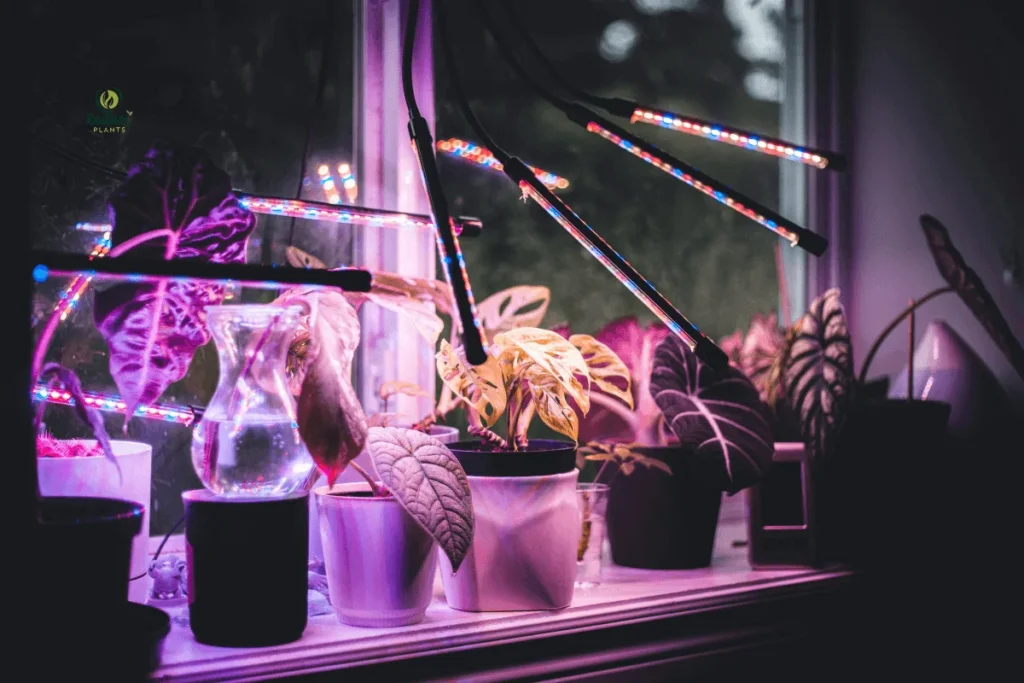
Different houseplant varieties have vastly different light requirements. Understanding the light conditions in your home forms the foundation of successful indoor plant care and determines which species will thrive in specific locations.
Light serves as plant food through photosynthesis—without adequate light, even perfect watering and fertilizing won’t produce healthy growth. Many struggling houseplants simply need better light positioning to transform their health.
Try these light optimization strategies:
- Measure light levels in different areas using a light meter app on your smartphone to move beyond vague terms like “bright indirect” and understand actual light values
- Supplement natural light with full-spectrum grow lights during darker months or in challenging spaces—modern LED options provide excellent plant-friendly light without excessive electricity costs
- Adjust seasonally by moving plants closer to windows during winter months when light intensity decreases naturally
- Match plants to available light rather than forcing shade-lovers into bright spots or sun-worshippers into dim corners
Pro Tip: Rotate your plants quarterly to ensure even growth patterns and prevent them from permanently leaning toward light sources. This simple habit promotes symmetrical growth and strengthens stems through balanced light exposure.
2. Master the Art of Proper Watering
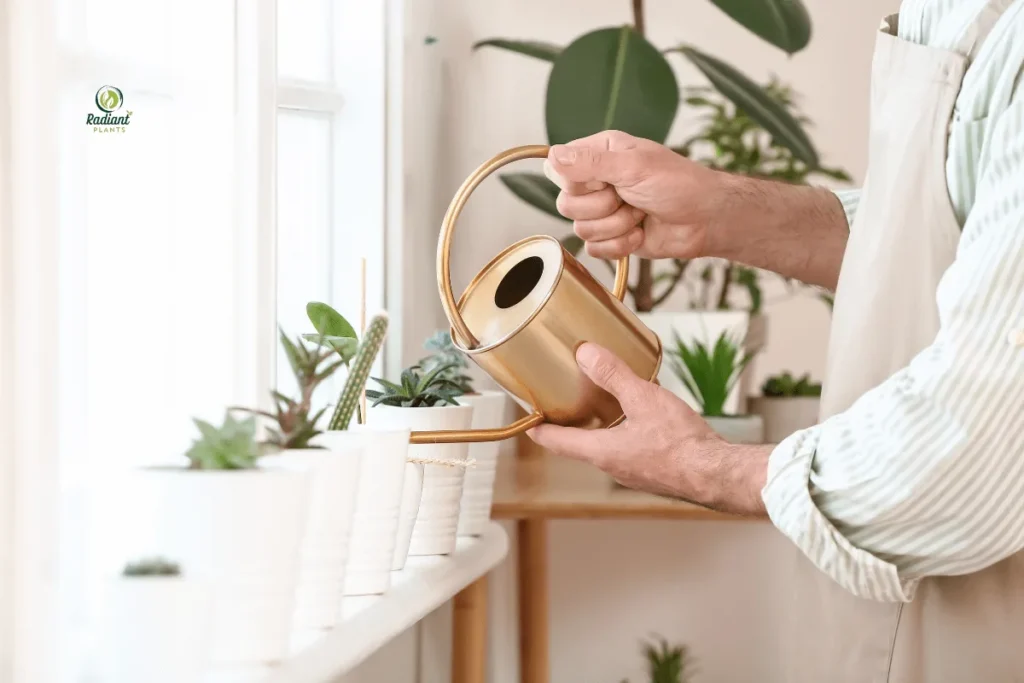
More houseplants die from improper watering than from any other cause. The secret to indoor plant care success often lies in understanding when and how much to water—a skill that develops through practice and observation rather than rigid schedules.
Water requirements vary dramatically between species, seasons, pot materials, and even individual plants. Learning to read your plant’s specific needs revolutionizes your care routine and growth results.
Perfect your watering technique with these approaches:
- Check soil moisture before watering by inserting your finger 1-2 inches into the soil—most plants prefer slight drying between waterings rather than constant dampness
- Implement bottom watering for certain plants by placing pots in shallow water for 15-30 minutes, allowing roots to absorb moisture from below, which encourages deeper root development
- Create seasonal watering patterns that account for natural growth cycles—most plants need significantly less water during dormant winter periods compared to active summer growth
- Recognize hydration signals to distinguish between overwatering symptoms (yellowing leaves, soft stems, moldy soil) and underwatering signs (crispy leaf edges, slow growth, soil pulling away from pot edges)
Tool Recommendation: A moisture meter takes the guesswork out of watering decisions and costs less than replacing dead plants. This simple probe provides objective readings about soil moisture levels at various depths, preventing both overwatering and underwatering mishaps.
3. Create a Humidity Haven
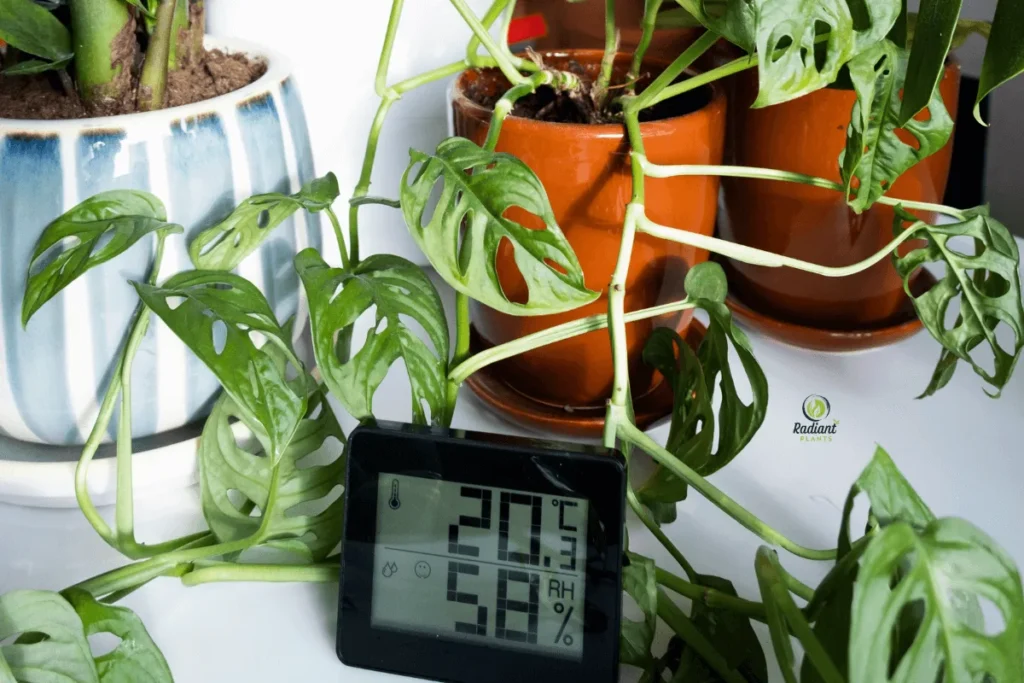
Many popular houseplants originate from humid tropical environments where atmospheric moisture levels regularly exceed 60%. Boosting humidity represents a critical aspect of indoor plant care that dramatically improves growth, particularly for tropical varieties suffering in dry indoor air.
Modern homes typically maintain humidity levels between 30-40%, far below what many houseplants prefer. This moisture deficit stresses plants, causing brown leaf tips, stunted growth, and increased vulnerability to pests.
Transform your home’s humidity with these methods:
- Group plants together to create natural humidity pockets as plants release moisture through transpiration, benefiting neighboring plants
- Create pebble trays by placing plants on trays filled with water and pebbles (keeping pot bottoms above water level) to generate localized humidity through evaporation
- Invest in humidifiers for significant humidity needs—ultrasonic models provide consistent moisture without heating concerns
- Select appropriate species for your natural humidity levels—succulents and cacti thrive in drier conditions, while calatheas and ferns demand higher humidity
Humidity impacts everything from leaf development to nutrient absorption, making it a powerful yet often overlooked growth factor in comprehensive indoor plant care.
4. Feed Your Plants Properly
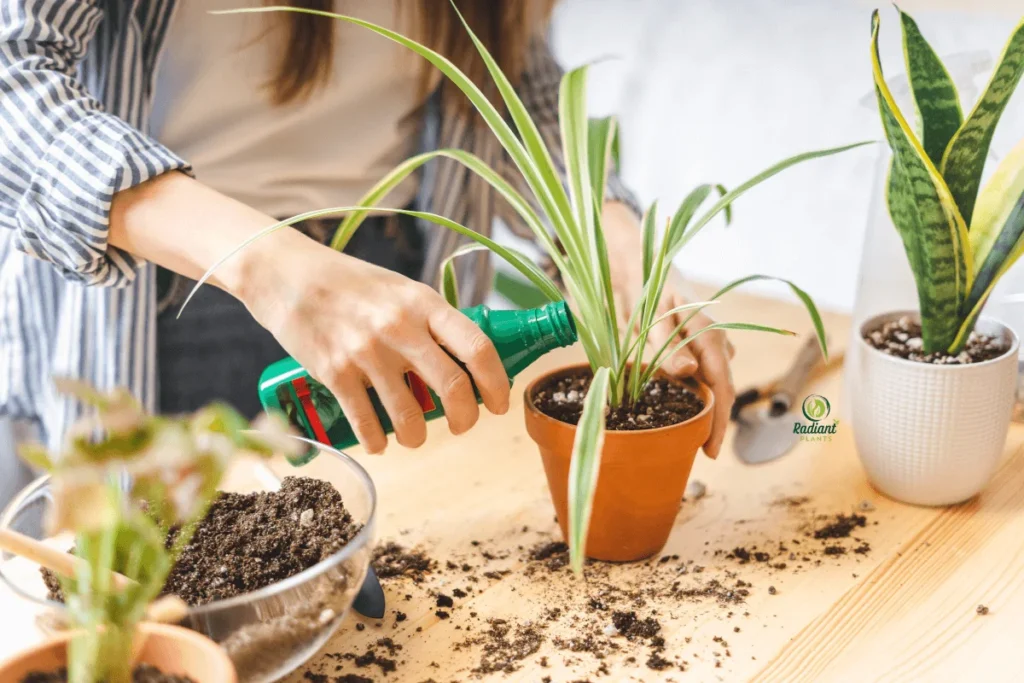
Just like humans, plants need balanced nutrition to thrive. Proper fertilization represents an essential component of indoor plant care that many beginners overlook, assuming potting soil provides indefinite nutrients.
In natural environments, plants access nutrients through decomposing organic matter and mineral-rich soils. Potted plants quickly deplete their limited soil resources, requiring supplemental feeding for continued healthy growth.
Develop a feeding strategy with these guidelines:
- Understand NPK ratios displayed on fertilizer packages (nitrogen-phosphorus-potassium)—higher nitrogen promotes leafy growth, phosphorus supports blooming, and potassium enhances overall plant health
- Follow seasonal feeding schedules that align with natural growth patterns—fertilize regularly during spring and summer growth periods, reduce or eliminate feeding during winter dormancy
- Compare organic versus synthetic options—organic fertilizers release nutrients slowly with less burn risk, while synthetic formulations provide immediate nutrient availability
- Recognize deficiency signals through leaf appearance—yellowing older leaves often indicate nitrogen deficiency, while purplish discoloration suggests phosphorus shortage
Always remember that under-fertilizing is safer than over-fertilizing, which can burn roots and damage plants. Begin with half-strength applications and adjust based on plant response.
5. Perfect Your Potting Practices
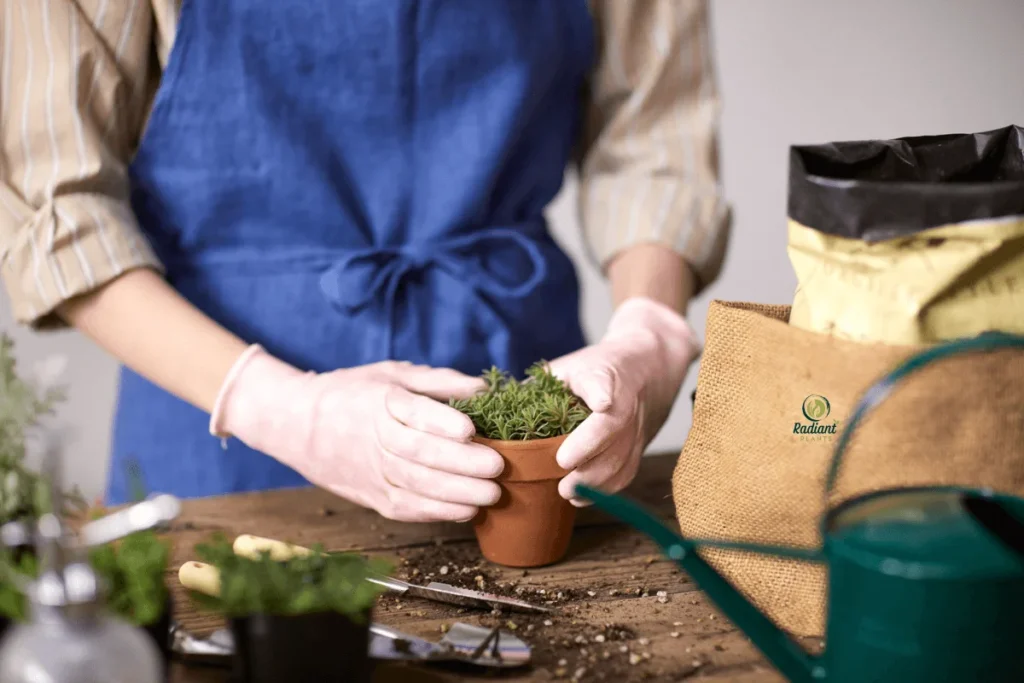
The container and growing medium significantly impact plant health and growth rate. Expert indoor plant care includes strategic potting decisions tailored to each plant’s specific requirements and growth habits.
Pot selection influences everything from moisture retention to root development space, while soil composition determines drainage, aeration, and nutrient availability. Together, these factors create the foundation for sustainable growth.
Enhance your potting approach with these techniques:
- Select appropriate pot sizes that allow 1-2 inches of growth space around roots—too large promotes overwatering issues, while too small restricts growth
- Choose optimal materials based on plant needs—porous terracotta provides excellent aeration but dries quickly, while plastic and glazed ceramics retain moisture longer
- Create custom soil blends for different plant categories—add perlite or pumice for drainage-loving varieties, while incorporating sphagnum moss for moisture-retentive mixes
- Master repotting timing by watching for signs like roots circling or growing through drainage holes, slowed growth despite proper care, or soil that dries extraordinarily quickly
Seasonal Tip: Most houseplants benefit from repotting in early spring as they enter their active growth phase. This timing allows them to quickly establish in fresh soil during their natural expansion period.
6. Prune for Performance
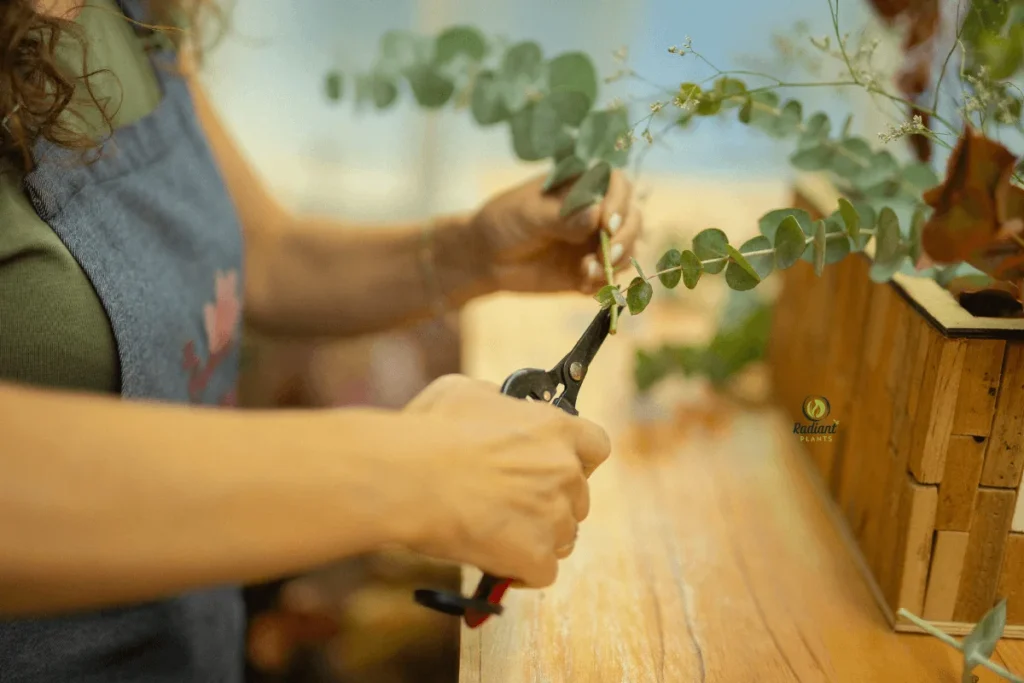
Regular pruning isn’t just about aesthetics—it’s a powerful indoor plant care technique that redirects energy and promotes fuller growth patterns that transform sparse plants into lush specimens.
Strategic cutting stimulates hormonal responses that activate dormant growth points, creating bushier plants with improved structural integrity. Proper pruning also removes unproductive growth, allowing plants to focus resources where they generate the greatest benefit.
Develop pruning confidence with these strategies:
- Identify strategic cutting points just above leaf nodes (where leaves attach to stems), which stimulate branching from that junction
- Invest in quality pruning tools like sharp bypass pruners that make clean cuts without crushing stems, reducing disease entry points
- Learn plant-specific techniques—pinching works well for herbs and soft-stemmed plants, heading back (removing growing tips) creates bushier growth, while thinning removes entire branches to improve air circulation
- Repurpose pruned sections through propagation, turning maintenance trimmings into new plants that expand your collection cost-free
Begin conservatively with pruning, removing no more than 25% of growth at once to prevent shock. Regular, moderate pruning produces better results than occasional aggressive cutting.
7. Maintain Ideal Temperature Ranges
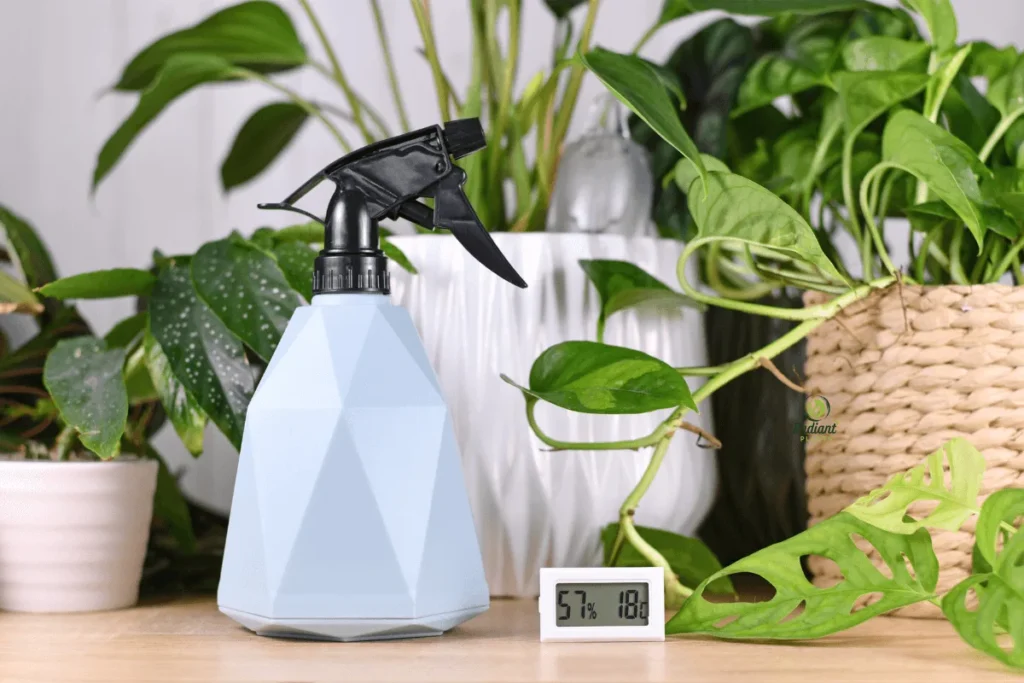
Temperature fluctuations can shock plants and stunt growth. Consistent, appropriate temperatures form a fundamental aspect of successful indoor plant care that affects metabolic processes, water requirements, and overall vigor.
Most houseplants evolved in tropical or subtropical regions with relatively stable temperature patterns. Sudden fluctuations or extreme conditions disrupt their natural functioning and trigger stress responses that divert energy from growth.
Create temperature stability with these approaches:
- Research optimal ranges for your specific plants—most houseplants prefer temperatures between 65-85°F (18-29°C) during daytime hours with a slight nighttime drop
- Protect vulnerable plants from cold drafts near doors, windows, and air conditioning vents, which create micro-climate stress zones
- Adjust seasonal positioning to accommodate temperature changes—move plants away from cold windows in winter and cooling vents in summer
- Use temperature fluctuations strategically to trigger blooming in certain species like Christmas cactus and orchids, which respond to temperature differentials between day and night
Monitor temperatures in different areas of your home to identify ideal plant placements that avoid problematic hot or cold spots throughout changing seasons.
8. Prevent and Treat Common Pests
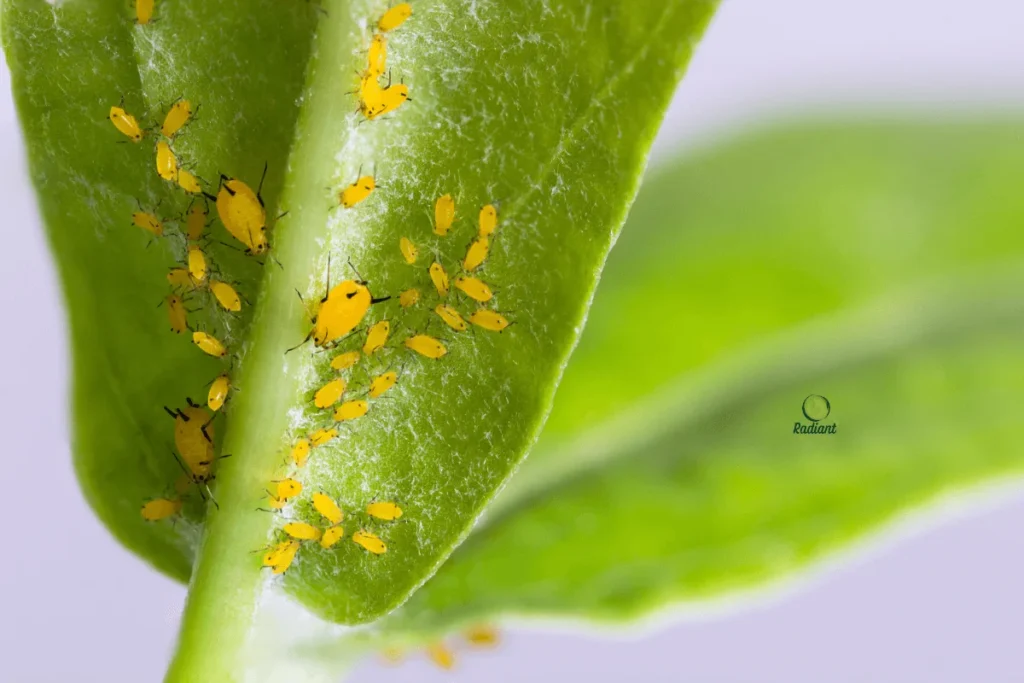
Pests can devastate indoor plants and halt growth practically overnight. Preventative measures represent a crucial part of indoor plant care that keeps your green friends thriving through early detection and appropriate intervention.
Houseplants face numerous potential invaders, including spider mites, mealybugs, scale insects, fungus gnats, and aphids. Each pest targets plants differently, but all drain resources intended for growth and introduce potential diseases.
Implement pest management with these techniques:
- Conduct regular inspections by checking leaf undersides, stem junctions, and soil surfaces weekly for early signs of trouble
- Maintain clean growing environments by removing dust from leaves, clearing debris from soil surfaces, and keeping surroundings free from decaying plant material
- Apply preventative treatments like neem oil monthly, which deters many common pests without harming beneficial insects
- Establish quarantine protocols for all new plants entering your home—isolate for 2-4 weeks away from existing collections to prevent pest transmission
When pests appear despite precautions, begin with the least toxic treatment options, like insecticidal soap sprays or horticultural oils, before considering stronger chemical interventions.
9. Support with Staking and Training
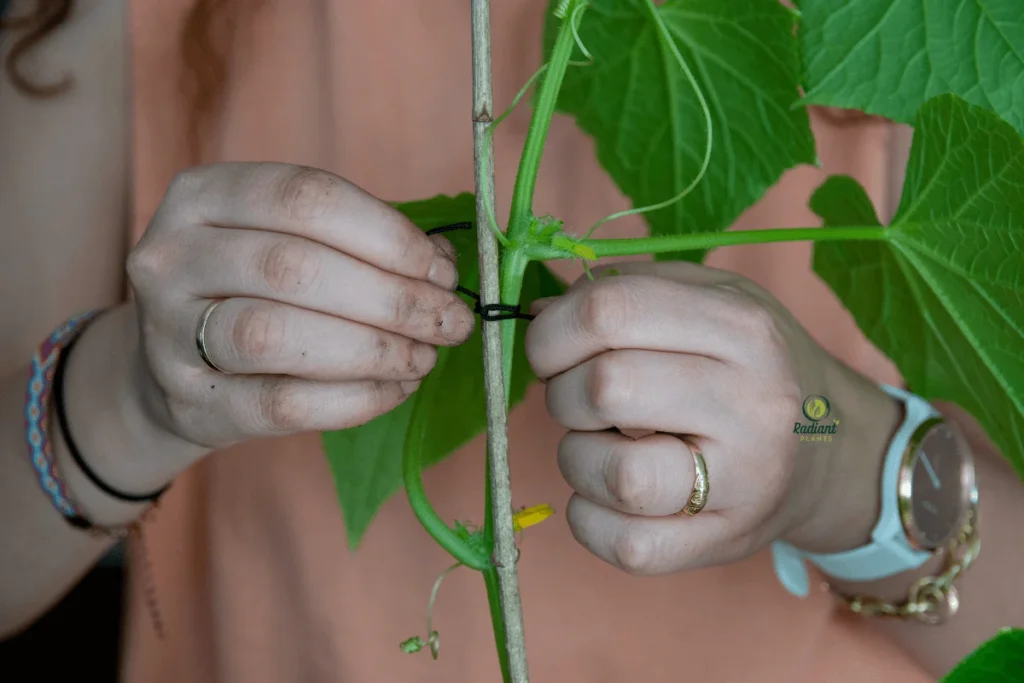
Many houseplants benefit from physical support that promotes stronger stems and better growth habits. This often-overlooked aspect of indoor plant care can transform leggy specimens into showcase plants with improved structure and presentation.
Support needs vary widely between species—vining plants require climbing structures, tall varieties need stabilization against toppling, and trailing types benefit from directional guidance that creates fuller displays.
Enhance plant architecture with these support strategies:
- Install appropriate stakes for tall-growing plants before they begin to lean, positioning supports near the plant center without damaging roots
- Provide climbing structures for natural climbers like pothos, monstera, and philodendron—moss poles retain moisture while providing naturalistic climbing surfaces
- Select materials thoughtfully based on plant weight and growth pattern—bamboo offers excellent strength for heavier plants, while coated wire works well for gentle guidance
- Implement training gradually by gently securing stems with soft plant ties, adjusting positions progressively rather than forcing dramatic directional changes
Beyond practical growth benefits, thoughtful support structures integrate into your décor scheme, transforming necessary plant care into aesthetic design elements that enhance your space.
10. Establish Seasonal Care Routines
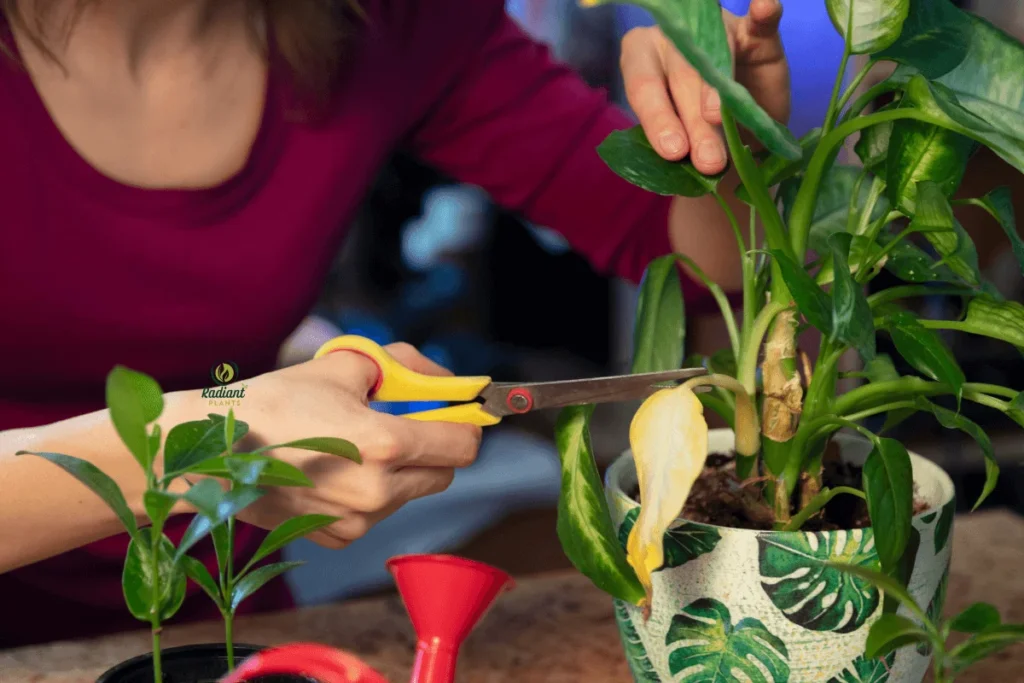
Even indoors, plants respond to seasonal changes. Adapting your indoor plant care routine throughout the year aligns with natural growth patterns and boosts overall plant health by working with inherent biological rhythms rather than against them.
Plants evolved with seasonal cues that trigger specific growth phases, dormancy periods, and reproductive cycles. Honoring these natural tendencies through seasonal care adjustments creates healthier specimens with predictable growth patterns.
Develop seasonal awareness with these cyclical approaches:
- Winter dormancy support includes reduced watering, eliminated fertilization, increased humidity to counter heating system effects, and grow light supplementation during short days
- Spring growth stimulation involves repotting root-bound plants, resuming regular fertilization, gradually increasing watering frequency, and strategic pruning of winter growth
- Summer maintenance focuses on increased watering for active growth, pest monitoring during prime insect seasons, protection from excessive heat and air conditioning drafts, and humidity support
- Fall preparation includes gradually reducing fertilizer applications, cleaning leaves before winter light reduction, beginning the transition to winter watering schedules, and moving plants away from cooling windows
This seasonal approach acknowledges that plants aren’t static decorations but living organisms with cyclical needs that change throughout the year. Respecting these cycles enhances growth while reducing care frustrations.
Shocking Causes of Brown Spots on Plant Leaves & Quick Fixes!
Indoor Plant Care Success: Matching Methods to Plant Types
Different plant categories require specific approaches to care. Use this chart to identify the best growth-boosting techniques for your particular houseplants:
Plant Type | Light Needs | Watering Frequency | Humidity Requirements | Growth Boosting Focus |
|---|---|---|---|---|
Tropical Foliage (Monstera, Pothos) | Bright indirect | High (50- 60%+) | High (50-60%+) | Humidity, regular fertilizing |
Succulents & Cacti | Direct sunlight | When completely dry | Low (30-40%) | Well-draining soil, light |
Ferns | Filtered light | Keep consistently moist | Very high (60%+) | Humidity, consistent moisture |
Flowering Plants | Bright indirect/direct | Moderate, even moisture | Moderate (40-50%) | Bloom-specific fertilizer |
Air Plants | Bright indirect | Weekly misting/soaking | Moderate to high | Air circulation, proper drying |
Understanding these category-specific requirements allows you to group plants with similar needs, streamlining care routines while improving growth outcomes across your entire collection.
The Indoor Plant Care Calendar: Month-by-Month Growth Guide
For maximum growth results, follow this seasonal indoor plant care schedule that takes the guesswork out of timing crucial plant care activities:
Spring (March-May)
- Repot root-bound plants into containers one size larger with fresh potting mix
- Begin regular fertilization at half-strength, gradually increasing to full strength
- Increase watering frequency and volume as growth accelerates and day length increases
- Prune leggy winter growth to encourage compact, bushier development during the prime growing season
Summer (June-August)
- Protect sensitive varieties from excessive heat and air conditioning drafts that cause stress
- Increase humidity through regular misting, grouping, or humidifiers to counter summer dryness
- Monitor for pests more frequently during their active reproduction season
- Provide extra water for thirsty plants during peak growth and evaporation periods
Fall (September-November)
- Gradually reduce fertilization frequency and strength as growth naturally slows
- Begin transitioning to winter watering schedule with less frequent, thorough waterings
- Clean leaves thoroughly to maximize light absorption during the upcoming lower-light months
- Move plants away from cooling windows that will soon become danger zones of cold drafts
Winter (December-February)
- Reduce watering significantly, allowing the soil to dry more between applications
- Hold fertilization entirely until late winter when new growth begins appearing
- Supplement with grow lights during short days, particularly for light-loving varieties
- Increase humidity to counter extremely dry heating air that stresses tropical varieties
This calendar system prevents common seasonal mistakes like continuing summer care routines into winter dormancy periods or failing to adjust for changing light conditions throughout the year.
Conclusion: Growing Success Through Consistent Indoor Plant Care
Implementing these ten proven growth-boosting techniques will transform your relationship with your houseplants and their appearance in your space. Remember that successful indoor plant care isn’t about following rigid rules but about observing your plants and responding to their needs. Start with one or two strategies that address your plants’ most pressing issues, then gradually incorporate the others. With patience and these expert approaches, you’ll create an indoor garden that thrives year-round, bringing beauty, improved air quality, and a sense of accomplishment to your home.
The sense of achievement when a struggling plant produces its first new leaf under your improved care creates a genuine connection to nature that few other home activities can match. This living response to your attention reinforces the relationship between caretaker and plant, creating a satisfying feedback loop that enhances wellbeing.
Whether you’re nurturing your first pothos or expanding your collection of rare aroids, these indoor plant care principles apply across the spectrum. The joy of watching a plant unfurl new leaves because of your improved care is unmatched—it’s a small miracle that connects us to nature even in urban environments. Now it’s your turn to transform your space into the lush, thriving indoor garden you’ve always wanted.
Take the first step today by assessing your plants’ current conditions and selecting one growth-boosting technique to implement this week. Your plants will respond with visible improvement, encouraging continued care refinements that build upon each success. Before long, friends will marvel at your “natural” plant talent—a skill you’ve thoughtfully developed through understanding and implementing these essential growth principles.
FAQ: Indoor Plant Care Essentials
How often should I water my indoor plants?
The frequency depends on the plant type, pot size, and environment. Rather than following a strict schedule, practice proper indoor plant care by checking the soil moisture first. Most houseplants prefer drying out slightly between waterings. Insert your finger about an inch into the soil—if it feels dry at that depth, it’s usually time to water thoroughly until moisture runs through the drainage holes.
Why are my indoor plant’s leaves turning yellow despite following care instructions?
Yellowing leaves can indicate several issues in your indoor plant care routine, including overwatering, underwatering, nutrient deficiencies, or pest problems. Check the soil moisture level first, then examine for pests and consider when you last fertilized. Consistent yellowing of older, lower leaves often signals nitrogen deficiency, while yellowing across all leaves frequently indicates watering problems. Adjust one variable at a time to identify the specific cause.
What’s the best fertilizer for boosting indoor plant growth?
For general indoor plant care, a balanced liquid fertilizer with an NPK ratio of 10-10-10 works well for most houseplants. Flowering plants may benefit from higher phosphorus formulations, while foliage plants prefer higher nitrogen. Organic options like worm castings provide slower, steadier nutrient release, while synthetic fertilizers deliver immediate nutrition. Always dilute to half-strength initially to prevent potential root burn, especially with sensitive varieties.
How do I know when to repot my indoor plants?
Signs that repotting should be part of your immediate indoor plant care agenda include: roots growing through drainage holes, water running straight through the pot without absorption, slowed growth despite proper care, and the plant becoming top-heavy or falling over. Most houseplants benefit from repotting every 1-2 years, ideally in spring when they enter active growth phases. Choose containers only 1-2 inches larger than the current pots to prevent overwatering issues with excess soil.
Can indoor plants grow as well as they would outside?
With proper indoor plant care techniques that address light, humidity, and nutrition, many houseplants can thrive indoors. Some tropical varieties prefer the stable conditions of indoor environments compared to outdoor fluctuations. While growth rates might be somewhat slower indoors due to light limitations, many species achieve remarkable development with appropriate care. Focus on selecting plants naturally adapted to indoor light levels rather than struggling to grow full-sun varieties in limited light conditions.
What’s the biggest mistake people make with indoor plant care?
The most common error is inconsistent watering—either too much or too little. Developing a system to check plants regularly and water according to individual needs rather than a calendar schedule is fundamental to successful indoor plant care. Creating a weekly “plant day” for thorough inspection helps identify watering needs, emerging problems, and growth progress before issues become severe. Remember that benign neglect often proves less harmful than excessive attention, resulting in overwatering.
How can I boost growth for indoor plants in low-light conditions?
For challenging light situations, proper indoor plant care includes selecting appropriate low-light tolerant species, supplementing with grow lights, keeping leaves dust-free to maximize light absorption, and being especially careful not to overwater, since reduced light means slower water usage. Low-light specialists like ZZ plants, snake plants, pothos, and certain philodendrons can thrive in dimmer conditions that would starve light-hungry varieties. Position these plants as close as possible to whatever natural light exists while monitoring for signs of light stress, such as elongated stems or small leaves.

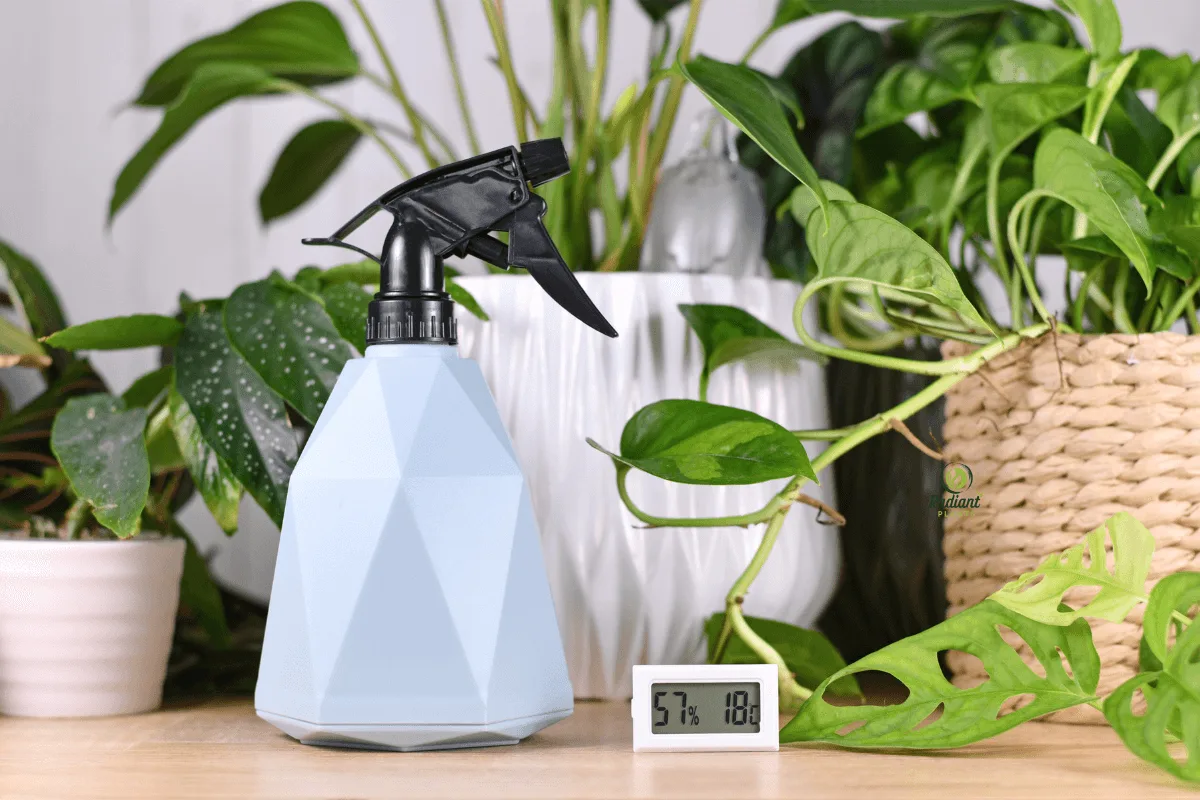
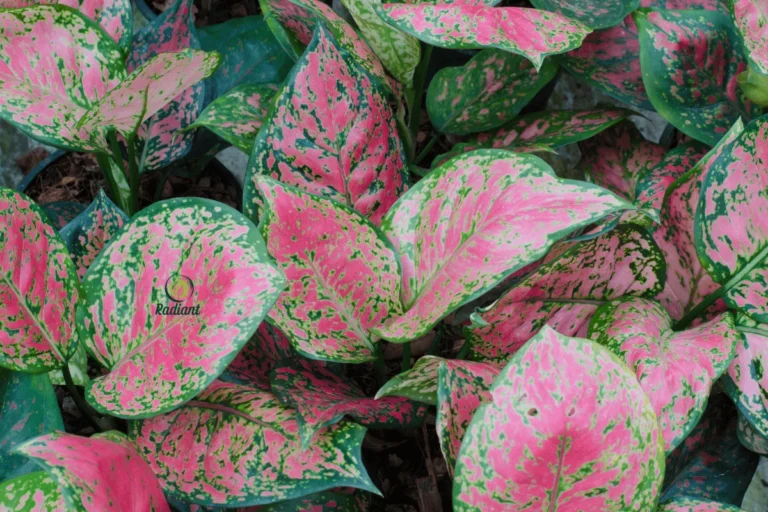
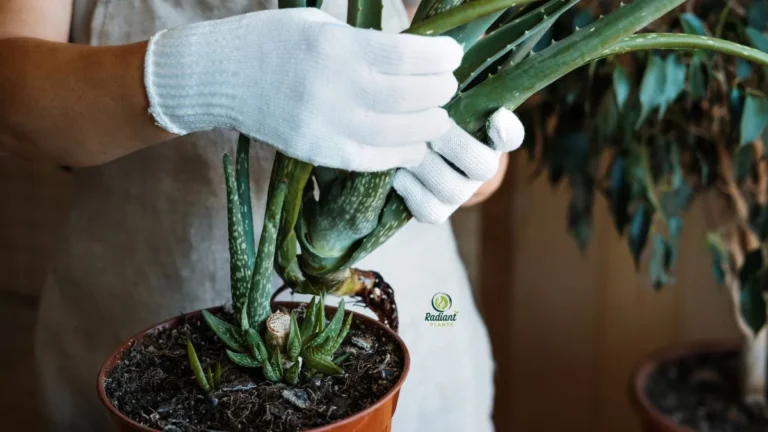
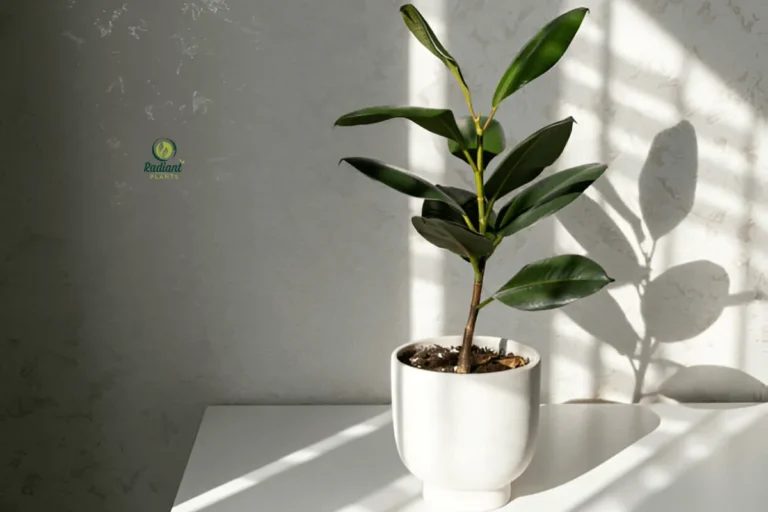
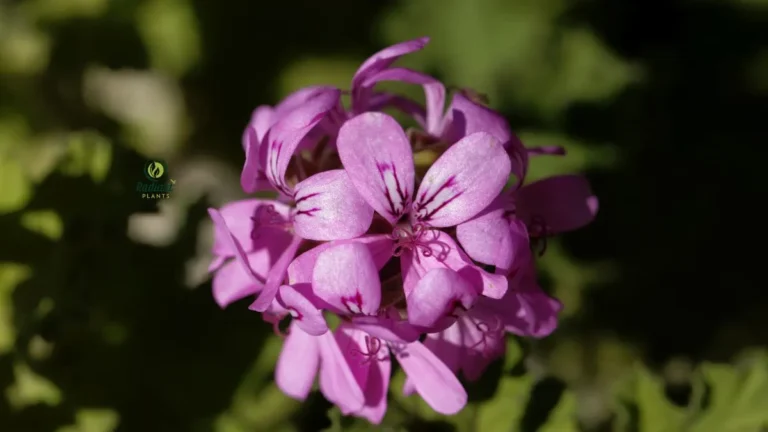
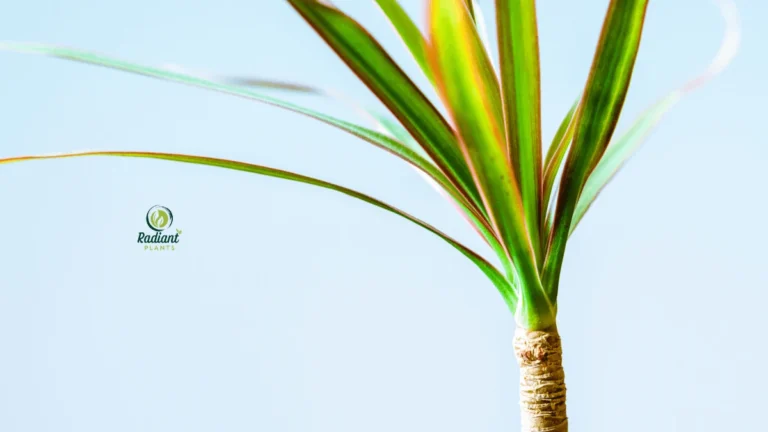

7 Comments